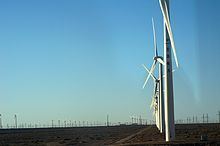Status Operational Type Onshore | Owner(s) multiple Construction began 2009 | |
 | ||
Nameplate capacity 7,965 MWPlanned: 20,000 MW | ||
The Gansu Wind Farm Project or Jiuquan Wind Power Base is a group of large wind farms under the construction in western Gansu province in China (40.2°N 96.9°E / 40.2; 96.9 40.6°N 96.9°E / 40.6; 96.9, 40.23°N 97.13°E / 40.23; 97.13). The Gansu Wind Farm Project is located in desert areas near the city of Jiuquan in two localities of Guazhou County and also near Yumen City, in the northwest province of Gansu, which has an abundance of wind resources.
Contents
The 8 GW of initial planned capacity of this wind farm is similar to that of the Kashiwazaki-Kariwa Nuclear Power Plant in Japan, which was the largest nuclear power plant in the world until its closure in 2012.
When fully completed the entire project may become the world's biggest collective windfarm.
Overview
The project is one of six national wind power megaprojects approved by the Chinese government. It is expected to grow to 20,000 megawatts by 2020, at an estimated cost of 120 billion Chinese yuan ($17.5 billion). The project is being built by more than 20 developers in two localities in Guazhou County and also near Yumen City.
Construction phases
The project is divided to multiple phases. The first 3,800 MW phase consisted of eighteen 200 MW wind farms and two 100 MW wind farms. The second 8,000 MW phase consists of forty 200 MW wind farms. The planned capacity is 5,160 MW by 2010, 12,710 MW by 2015 and 20,000 MW in 2020.
In 2008, construction began on a 750 kV AC power line to carry electricity from the wind farm, and construction of the wind farms themselves started in August 2009. Power is being purchased for 0.54 yuan per kWh, even though electricity from coal fired powerplants would be about half that price. Since operations began, some 6.26 billion kWh has been generated as of October 31, 2011 with 5.96 billion kWh of that produced in 2011.
In November 2010 officials announced the completion of the project's first phase, involving the installation of over 3,500 wind turbines with an installed capacity of approximately 5,160 MW according to Wang Jianxin, director of the Jiuquan Development and Reform Commission. Total installed capacity rose to approximately 6,000 MW in March 2012—roughly equivalent to the United Kingdom's entire wind power capacity at that time—with new wind turbines being erected at the rate of 36 per day.
Coordinated control centre
On March 1, 2012, a 'wind power coordinated control system' was implemented to adjust the output of the 18 wind farms of the Gansu Wind Farm Project, which total 10 GW, to meet the needs of the transmission grid, which is limited to 1.5 GW. This permitted the production of 1 GWh more per day than previously, and greatly improves the system's stability.
Curtailment of wind turbine operations is a first order method for dealing with the intermittency of wind, but normally loses available output when the power grid's transmission capacity has been reached. Other methods involve either added local industrial usage or added local storage capacity.
Demand and utilization
With stubborn local-government favoritism toward coal and inadequate long-distance transmission capacity, Gansu "now has some of the highest rates of underutilization in the wind sector in China". National Energy Administration statistics showed 39 percent of wind capacity in 2015 in Jiuquan was wasted.
